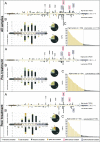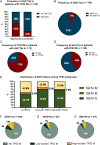Low-burden TP53 mutations represent frequent genetic events in CLL with an increased risk for treatment initiation
- PMID: 37987115
- PMCID: PMC10766018
- DOI: 10.1002/cjp2.351
Low-burden TP53 mutations represent frequent genetic events in CLL with an increased risk for treatment initiation
Abstract
TP53 aberrations predict chemoresistance and represent a contraindication for the use of standard chemoimmunotherapy in chronic lymphocytic leukaemia (CLL). Recent next-generation sequencing (NGS)-based studies have identified frequent low-burden TP53 mutations with variant allele frequencies below 10%, but the clinical impact of these low-burden TP53 mutations is still a matter of debate. In this study, we aimed to scrutinise the subclonal architecture and clinical impact of TP53 mutations using a sensitive, NGS-based mutation analysis in a 'real-world' cohort of 901 patients with CLL. In total, 225 TP53 mutations were identified in 17.5% (158/901) of the patients; 48% of these alterations represented high-burden mutations, while 52% were low-burden TP53 mutations. Low-burden mutations as sole alterations were identified in 39% (62/158) of all mutated cases with 82% (51/62) of these being represented by a single low-burden TP53 mutation. Patients harbouring low-burden TP53 mutations had significantly lower time to first treatment compared to patients with wild-type TP53. Our study has expanded the knowledge on the frequency, clonal architecture, and clinical impact of low-burden TP53 mutations. By demonstrating that patients with sole low-burden TP53 variants represent more than one-third of patients with TP53 mutations and have an increased risk for treatment initiation, our findings strengthen the need to redefine the threshold of TP53 variant reporting to below 10% in the routine diagnostic setting.
Keywords: NGS; TP53; chronic lymphocytic leukaemia.
© 2023 The Authors. The Journal of Pathology: Clinical Research published by The Pathological Society of Great Britain and Ireland and John Wiley & Sons Ltd.
Figures




References
-
- Hallek M, Cheson BD, Catovsky D, et al. iwCLL guidelines for diagnosis, indications for treatment, response assessment and supportive management of CLL. Blood 2018; 131: 2745–2760. - PubMed
-
- Hallek M. Chronic lymphocytic leukemia: 2020 update on diagnosis, risk stratification and treatment. Am J Hematol 2019; 94: 1266–1287. - PubMed
-
- Pospisilova S, Gonzalez D, Malcikova J, et al. ERIC recommendations on TP53 mutation analysis in chronic lymphocytic leukemia. Leukemia 2012; 26: 1458–1461. - PubMed
-
- Döhner H, Stilgenbauer S, Benner A, et al. Genomic aberrations and survival in chronic lymphocytic leukemia. N Engl J Med 2000; 343: 1910–1916. - PubMed
Publication types
MeSH terms
Substances
Grants and funding
- Elixir Hungary
- 739593/EU's Horizon 2020 Research and Innovation Program
- BO/00125/22/Magyar Tudományos Akadémia
- EFOP-3.6.3-VEKOP-16-2017-00009/Ministry of Innovation and Technology of Hungary from the National Research, Development and Innovation Fund
- FK20_134253/Ministry of Innovation and Technology of Hungary from the National Research, Development and Innovation Fund
- K21_137948/Ministry of Innovation and Technology of Hungary from the National Research, Development and Innovation Fund
- TKP2021-EGA-24/Ministry of Innovation and Technology of Hungary from the National Research, Development and Innovation Fund
- TKP2021-NVA-15/Ministry of Innovation and Technology of Hungary from the National Research, Development and Innovation Fund
- ÚNKP-22-3-II-SE-21/Ministry of Innovation and Technology of Hungary from the National Research, Development and Innovation Fund
LinkOut - more resources
Full Text Sources
Research Materials
Miscellaneous

